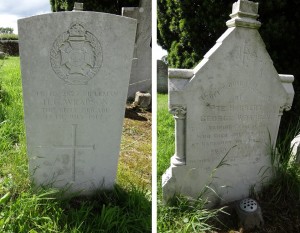 Regiment: 10th Battalion, The Rifle Brigade.
Regiment: 10th Battalion, The Rifle Brigade.
Service No: TR/10/2527
Date & place of birth: 23 September 1898 in Heyshott, Sussex
Date & place of death: 14 July 1917 (aged 18) at St Albans, Hertfordshire
Herbert Wrapson spent the majority of his short military service unwell and died in a military hospital of pleurisy and heart failure, aged 18.
Family background
Herbert George Wrapson was born in Heyshott on 23 September 1898, the third child and only son of George Wrapson (1859–1932) and his wife Charlotte née Tiller (1867–1942). George had been born in Heyshott and married local girl Charlotte in late 1889. Their first child, Ethel, was born in September 1890, followed by Florence in January 1894.
At the time of Herbert’s birth in September 1898, the family were living with Charlotte’s father, Thomas Tiller (a widower) at Coldharbour in Heyshott, where George Wrapson worked as a farm labourer. Ten years later, the family were still at Coldharbour, when George gave his occupation as a road foreman, employed by Midhurst Rural District Council.
By this time, Herbert’s sisters were both in service. Ethel was employed by Francis Albert Rollo Russell, the son of Lord Russell, who had been Prime Minister from 1846 to 1852 and again between 1865 and 1866. Francis Russell described himself in the 1911 census as an author, but he was better known as a meteorologist and an early environmentalist, who studied the causes of the London smog. Florence was employed by John Taylor, a shopkeeper in North Street, Midhurst.
At the time he joined the army in 1916, Herbert gave his occupation as a gardener and his address as Briarwood Cottage, Nyewood, near Rogate, although his parents were still living at Coldharbour.
Military service
Herbert attested at Chichester on 13 September 1916, a few days before his 18th birthday. He was initially placed on the reserve list and was mobilised into the Rifle Brigade (The Prince Consort’s Own) in February 1917, having undergone basic training.
By the time of his death, he had been transferred to the 21st Training Reserve Battalion.
Death and commemoration
He was first admitted to hospital at Aylesbury on 16 March 1917 with a cough and bad chest, which was diagnosed as bronchitis. He was discharged from hospital on 27 March, only to be re-admitted on 3 April, this time into the Middlesex War Hospital at Napsbury near St Albans, with pleuritic effusion. He failed to recover and died at the hospital on 14 July. The causes of death were given as “Pleurisy with effusion” and “Empyema; Heart Failure”.
At the request of his family, his body was returned to Heyshott where he was buried in the north-west corner of St James churchyard. As well as the Commonwealth War Graves Commission headstone, he also has a family headstone on the same grave.
He is commemorated on the war memorial window inside St James Church, Heyshott.